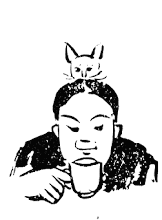Darwin and Scarlet Cloth/ 达尔文与一块红布
Michael Taussig, Mimesis and Alterity: A Particular History of the Senses (New York: Routledge, 1993).
Take
Both parties laughing, wondering, gaping at each other; we pitying them, for giving us good fish and crabs for rags, etc.,; they grasping at the chance of finding people so foolish as to exchange such splendid ornaments for a good supper. It was most amusing to see the undisguised smile of satisfaction with which one young woman with her face painted black, tied several bits of scarlet cloth round her head with rushes. (227) [End Page 94]
That was 1832, by which time the European bourgeoisies, male versions, unlike the aristocracy and Middle Ages of time past, were deeply invested in grey to a degree that brilliant colors such as red took on a wild, primitive, not to mention even a revolutionary hue—obviously the perfect gift for the Fuegians (whom, we are later told, had the practice of daubing their naked bodies with black, white, and red). But from the beginning of European discovery and conquest, redness itself, first from a species of tree in India, called Brasilium on account of its fieriness, and later from Bahia (in what came to be called Brasil), and from Central and South America, fetched enormous prices in Europe into the eighteenth century. Indeed, after gold and silver and perhaps slaves, the commodity that seems to have most interested the buccaneers of


没有评论:
发表评论